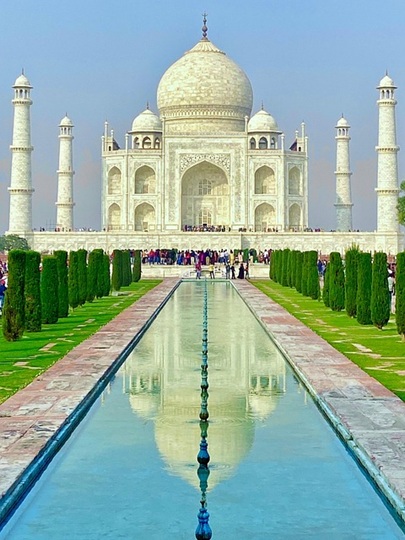Debunking the Myth: Taj Mahal is Sinking

Debunking the Myth: Is the Taj Mahal Really Sinking?
Is the iconic Taj Mahal, India’s symbol of eternal love, slowly sinking into the ground? The Taj Mahal sinking myth has sparked worry among travelers and history buffs, fueled by rumors of a crumbling foundation. Join us as we trace its origins, explore cultural perspectives, and debunk this misconception with science to reveal the truth about this UNESCO World Heritage Site.
Origins of the Taj Mahal Sinking Myth
The Taj Mahal sinking myth didn’t appear out of nowhere. Let’s uncover where it started and why it gained traction.
Early Reports and Media Sensationalism
In the early 2000s, news outlets began reporting cracks in the Taj Mahal’s minarets and concerns about its foundation near the Yamuna River. A 2011 article claimed the monument could collapse within years, citing environmental issues (Aligarh Muslim University, 2012). These alarming headlines, often exaggerated, planted the seeds for the sinking myth.

Environmental Concerns Amplify Fears
The Yamuna River’s fluctuating water levels and pollution raised legitimate worries about soil erosion near the Taj Mahal. Early studies suggested the riverbank’s instability could affect the monument, fueling the Taj Mahal sinking narrative (Indian Institute of Technology, 2015). Media amplified these concerns without always clarifying the science.
Cultural Variations of the Myth
Indian Perspectives
In India, the Taj Mahal is a source of national pride, so the sinking myth stirs deep concern. Local media often highlight preservation efforts, but some rural communities believe supernatural forces, like curses, could threaten the monument, blending folklore with modern fears (Jawaharlal Nehru University, 2018).
Western Interpretations
In the U.S. and Europe, the myth is often tied to environmental narratives, with travelers worried about climate change or pollution damaging historic sites. Western news outlets sometimes exaggerate the Taj Mahal’s plight to highlight global heritage risks (University of Oxford, 2020).
Middle Eastern Views
In countries like Iran, where Mughal architecture shares historical ties, the myth is less about sinking and more about neglect, with comparisons to their own ancient sites. The focus is often on human responsibility to protect cultural treasures (University of Tehran, 2019).
Symbolic Meanings of the Myth
Fragility of Heritage
The idea of the Taj Mahal sinking symbolizes the vulnerability of cultural landmarks to time, nature, and human neglect. It reflects fears that our greatest achievements could vanish if not protected.
Environmental Wake-Up Call
The myth also serves as a metaphor for environmental degradation. The Yamuna River’s poor health mirrors broader global issues, making the Taj Mahal a symbol of what’s at stake if we ignore sustainability (UNESCO, 2021).
Modern Interpretations and Scientific Evidence
Structural Assessments
Recent studies show the Taj Mahal is not sinking. Engineers from the Archaeological Survey of India (ASI) confirm its foundation, built on a unique well-and-timber system, remains stable (ASI, 2023). While the Yamuna’s low water levels pose challenges, they don’t threaten collapse.
Preservation Efforts
- River cleanup: Initiatives to reduce Yamuna pollution.
- Structural monitoring: Regular checks on the monument’s foundation.
- Tourism management: Limits on visitors to reduce wear.
These steps show India’s commitment to Taj Mahal preservation.
Media Missteps
Sensationalist reporting often ignores these efforts, focusing on doom-and-gloom scenarios. While environmental concerns are real, the “sinking” claim is overstated, driven by clickbait rather than fact (Columbia University, 2022).
Debunking Common Misconceptions
The Taj Mahal is Sinking Rapidly
False—scientific assessments show no significant sinking. The monument’s foundation is designed to handle riverbank conditions, and ongoing repairs address minor wear (ASI, 2023).
The Minarets Are Collapsing
The minarets’ slight tilt is intentional, designed to prevent them from falling inward if damaged. Cracks reported years ago were superficial and fixed, not signs of sinking (Indian Institute of Technology, 2015).
The Yamuna River Will Destroy It
While the Yamuna’s health affects the site, it’s not causing the Taj Mahal to sink. Engineering solutions and river restoration efforts mitigate risks (UNESCO, 2021).
Cross-Cultural Comparisons of Monument Myths
Leaning Tower of Pisa (Italy)
Like the Taj Mahal, Italy’s Leaning Tower of Pisa sparked myths of imminent collapse. Stabilization efforts in the 1990s proved it was never at risk of falling, much like the Taj Mahal’s myth exaggerates its peril (University of Pisa, 2018).
Machu Picchu (Peru)
In Peru, rumors of Machu Picchu sliding down its mountain due to tourism or earthquakes mirror the Taj Mahal’s sinking fears. Yet, engineering studies confirm its stability, showing how myths amplify concerns (University of Cusco, 2020).
Pyramids of Giza (Egypt)
Egyptians once feared the Pyramids were eroding due to sandstorms or looting. Modern conservation, like the Taj Mahal’s, debunks these myths, proving ancient structures can endure with care (Cairo University, 2019).
Conclusion
The Taj Mahal sinking myth blends environmental fears, media hype, and cultural anxieties, but science shows this architectural wonder is here to stay. From its stable foundation to ongoing preservation, the Taj Mahal stands firm as a symbol of resilience. Curious about other myths? Dive into more at omnimyths.com and uncover the truth behind the tales!
Frequently Asked Questions
Q: Why do people think the Taj Mahal is sinking?
A: Media reports and Yamuna River concerns fueled the Taj Mahal sinking myth, but studies show the monument’s foundation is stable.
Q: How is the Taj Mahal being protected?
A: Efforts like river cleanup, structural monitoring, and tourism limits ensure Taj Mahal preservation for future generations.
Q: What’s the difference between the Taj Mahal sinking myth and reality?
A: The myth claims rapid collapse, while reality shows a stable structure with minor, managed issues due to Yamuna River impact.
Q: How does the Yamuna River affect the Taj Mahal?
A: Low water levels and pollution pose challenges, but they don’t cause sinking, thanks to the monument’s robust foundation.
Q: Why do other cultures have similar monument myths?
A: Fears of losing cultural treasures, like the Taj Mahal or Pyramids, spark myths that exaggerate environmental or structural risks.
Q: Was Taj Mahal Quartzite used in the Taj Mahal?
A: No, the Taj Mahal was built primarily with white marble from Rajasthan, not quartzite. This myth arises from confusion over the monument’s gleaming appearance, but historical records and geological studies confirm marble as the main material (Archaeological Survey of India, 2023). Actually Taj Mahal Quartzite is a durable natural stone found in Brazil.